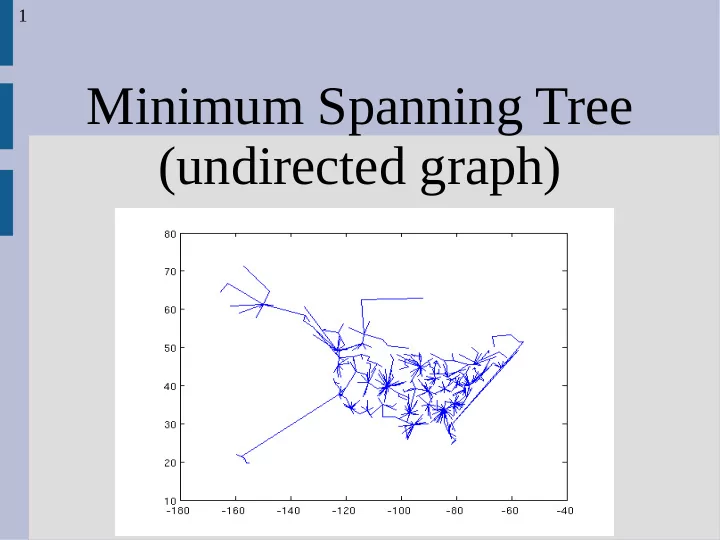

1 Minimum Spanning Tree (undirected graph)
2 Path tree vs. spanning tree We have constructed trees in graphs for shortest path to anywhere else (from vertex is the root) Minimum spanning trees instead want to connect every node with the least cost (undirected edges)
3 Path tree vs. spanning tree Example: build the least costly road that allows cars to get from any start to any finish
4 Safe edges We an find (again) a greedy algorithm to solve MSTs We can repeatedly add safe edges to an existing solution: 1. Find (u,v) as safe edge for A 2. Add (u,v) to A and repeat 1.
5 Safe edges A cut S: (S, V-S) for any verticies S Cut S respects A : no edge in A has one side in S and another in V-S
6 Safe edges A cut S: (S, V-S) for any verticies S Cut S respects A: no edge in A has one side in S and another in V-S S respects A if no red edges S = circles V-S = squares
7 Safe edges Theorem 23.1: Let A be a set of edges that is included in some MST Let S be a cut that respects A Then the minimum edge that crosses S and V-S is a safe edge for A
8 Safe edges blue = minimum Theorem 23.1: safe edge A = red edges LHS = S RHS = V-S
9 Safe edges Proof: Let T be a MST that includes A Add minimum safe edge (u,v) Let (x,y) be the other edge on the cut Remove (x,y), and call this T' thus: w(T') = w(T) + w(u,v) - w(x,y) But (u,v) min, so w(u,v) < w(x,y) Thus, w(T ' ) < w(T) and we done
10 Kruskal Idea: 1. Sort all edges into a list 2. If the minimum edge in the list does not create a cycle, add it to A 3. Remove the edge and repeat 2 until no more edges
11 Kruskal MST-Kruskal(G,w) A = { } for each v in G.V: Make-Set(V) sort(G.E) for (u,v) in G.E (w(u,v) increasing) if Find-Set(u) ≠ Find-Set(v) A= A U {(u,v)} Union(u,v)
12 Kruskal
13 Prim
14 Kruskal Runtime: Find-Set takes about O(lg |V|) time (Ch. 21) Thus overall is about O(|E| lg |V|)
15 Prim Idea: 1. Select any vertex (as the root) 2. Find the shortest edge from a vertex in the tree to a vertex outside 3. Add this edge (and the connected vertex) to the tree 4. Goto 2. Like Dijkstra, but different relaxation
16 Prim MST-Prim(G, w, r) // r is root for each u in G.V: u.key=∞, u.π=NIL r.key = 0, Q = G.V modified “relax” while Q not empty from Dijkstra u = Extract-Min(Q) for each v in G.Adj[u] if v in Q and w(u,v) < v.key v.key=w(u,v), v.π=u
17 Prim Runtime: Extract-Min(V) is O(lg |V|), run |V| times is O(|V| lg |V|) for loop runs over each edge twice, minimizing (i.e. Decrease-Key())... O( (|V|+|E|) lg |V| ) = O(|E| lg |V|) (Fibonacci heaps O(|E| + |V| lg |V|))
18 Prim
Recommend
More recommend